
Top Ten Must-See Sights in Washington, D.C.
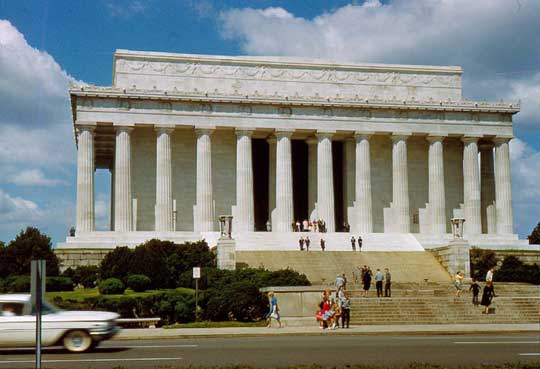
1. Lincoln Memorial
This a tribute to the great president that is awe inspiring in its proportions--the one monument that represents the city more than any other. The care and cost that went into this structure is both self-evident and mind boggling--the walls, attic, and columns are all solid marble from Colorado. Inside, there is a statue of Lincoln that is 30 feet tall from the floor to the top of his head, pieced together from 28 blocks of Georgia marble. The walls of the statuary chamber are made of Indiana limestone and inscribed with his two greatest speeches: on one side is his Gettysburg Address; on the other is his second inaugural address. Martin Luther King, Jr., gave his iconic "I Have a Dream" speech on the steps in 1963, and an inscription marks the spot.
Address: 2 Lincoln Memorial Circle, N.W., Washington, DC
Metro: Foggy Bottom. An alternative is to disembark at the Smithsonian Metro stop and take the Circulator bus to the Lincoln Memorial.
Photograph: Anonymous, 1961. © Peter R. Penczer
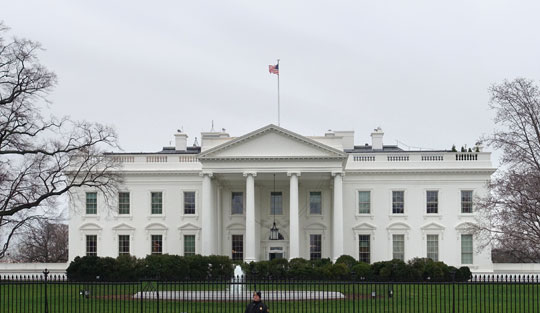
2. White House
The White House is, of course, the home of the president of the United States, and no trip to Washington would be complete without at least a look at the house. The exterior is best seen from Pennsylvania Avenue, on the north side. This is the front of the house--after all, the address is 1600 Pennsylvania Avenue, N.W.--and it is the closest that you can get without a ticket for the tour. President Bill Clinton closed this section of the avenue, between 15th and 17th streets, in 1995 after the Oklahoma City bombing, so you will have to park your car, which is not easy here, and walk. (Farragut West Metro stop is only two blocks away.) The closest vantage point to the south side is on E Street, which is also closed to traffic. The best view from a car is on Constitution Avenue at 16th Street. There are good views of the White House from the Washington Monument and the Jefferson Memorial as well.
To see the inside, you will need to get a ticket for the tour from your congressman, or from your embassy if you are from a foreign country. You should plan months in advance because it can take that long to get a spot on a tour. The tours start southeast of the house on 15th Street and wind their way through the first floor of the house following a prescribed path. The tour is not guided, but there are Secret Service officers present to answer questions.
The house itself was begun in 1792, only one year after the establishment of the city. President John Adams moved into the house in 1800 when Washington city became the official capital of the United States, so George Washington is the only president who never lived in the house. It was burned by the British in 1814, but rebuilt. President Harry Truman gutted the house in the early 1950s and rebuilt it in concrete and steel, so the only part of the house that predates 1950 is the exterior stonework and some of the furnishings. The first floor is for ceremonial purposes; the president lives on the second and third floors, which are not open to the public.
Address: 1600 Pennsylvania Avenue, N.W., Washington DC 20500
Metro: Farragut West or Farragut North
Photograph: © Peter R. Penczer 2016

3. U.S. Capitol
The U.S. Capitol is the most historically important building in the United States and, at the very least, every visitor should take a walk around the exterior. Unfortunately, the interior is much less accessible than it was before 9/11. There is a public tour that includes the rotunda (the large round room under the dome), the crypt (the room under the rotunda), and statuary hall, and that's it. It's worth taking--enter the visitor center through a descending ramp on the east side of the Capitol, and then get timed tickets. You will see one of the most forgettable films ever made before the guides lead you on the tour. The guides themselves are very good, and experts on the Capitol. It is also possible to take a tour through your congressman's office. Those tours might cover more ground, but they are sometimes led by interns reading off index cards. It is possible to see live debates in the House and Senate chambers, but you will need a pass from your congressman for that.
George Washington himself laid the cornerstone for the building in 1793. It was still under construction when the British burned it in 1814 during the War of 1812. By 1826, it was finished, or so they thought. Congress continued to grow as states were added, and work on the present wings began in 1850. As the wings progressed, the old wooden dome was replaced by the present dome, which is cast iron painted white to match the rest of the building, most of which is marble. The head of Freedom was bolted in place in 1863, completing the dome, and the wings were finished in 1867.
Metro: Capitol South or Union Station
Website: visitthecapitol.gov
Photograph: © Peter R. Penczer
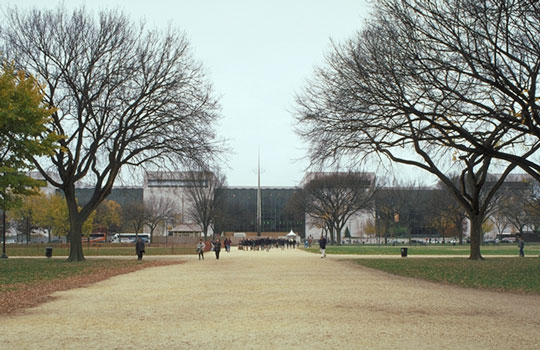
4. National Air and Space Museum
The United States dominated the history of aviation and space technology, and it shows in the top-notch exhibits here. On display are the crown jewels: the Wright brothers' 1903 Flyer, the world's first successful airplane; Charles Lindbergh's "Spirit of St. Louis," the first plane to cross the Atlantic Ocean from continent to continent; the Bell X-1, in which Captain Charles E. "Chuck" Yeager was the first to break the sound barrier, in 1947; the Apollo 11 command module Columbia, used in the first mission to put astronauts on the moon; and much more.
The museum has excellent exhibits on commercial air travel, aerial surveillance, ballistic missiles, and many other topics, plus IMAX films and flight simulators for an extra charge. Admission to the museum itself is free, and it is open every day of the year but Christmas. The National Air and Space Museum is the most-visited museum in the world (or number two, depending on the year) but it's large enough that it never seems terribly crowded. Security lines can get long at busy times; there are two lines, on the park side and on Constitution Avenue, and sometimes one can be much shorter than the other.
Address: 600 Independence Avenue, S.W. Washington, DC 20560
Metro: L'Enfant Plaza
Photograph: © Peter R. Penczer
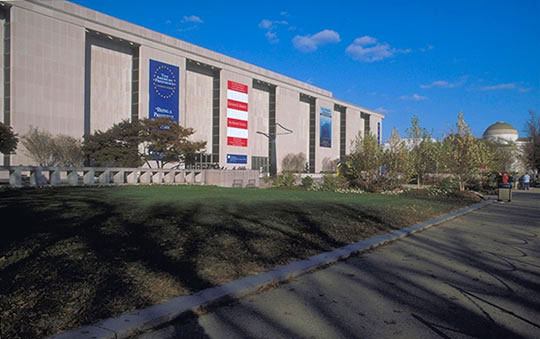
5. National Museum of American History
Visitors to the American History Museum will see the single most important object in Washington: The Star-Spangled Banner, the massive flag that inspired the national anthem. The museum has three floors of exhibits that, at times, can seem disjointed and mazelike, but the many treasures here are worth the effort. Some highlights include The Price of Freedom, a military history exhibit that could be a museum unto itself; First Ladies—gowns belonging to the presidents' wives back to Martha Washington; America on the Move—transportation from buggies to locomotives; and other exhibits including America's rarest coins, a gunboat from the Revolutionary War, and Archie Bunker's chair.
Address: 1400 Constitution Avenue, N.W., Washington DC 20001
Metro: Smithsonian or Federal Triangle
Photograph: © Peter R. Penczer
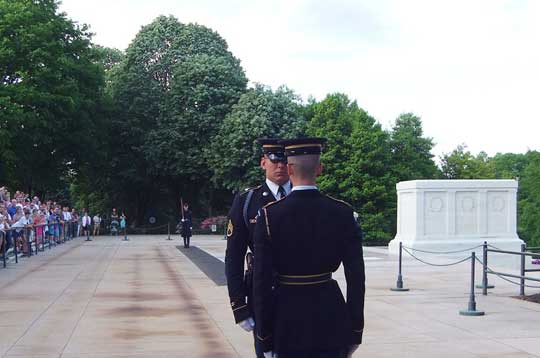
6. Tomb of the Unknown Soldier, Arlington Cemetery
The most sacred site for the U.S. military in the world. Underneath an enormous block of marble lies the unknown soldier of World War I; in front, under two crypt covers, are the unknown soldiers of World War II and the Korean War. (The Vietnam unknown was identified, and that grave is empty.) Guarding the tomb, soldiers of the 3rd U.S. Infantry Regiment march back and forth 24 hours per day with remarkable precision. The guards change every half hour in the summer and every hour on the hour in the winter. Visitors will see an elaborately choreographed ceremony in which the master of the guard inspects the uniform and weapon of the new guard.
The tomb is located in Arlington National Cemetery, just across the Potomac River from the Lincoln Memorial in Virginia. It is about a 20-minute walk from the cemetery entrance, at the top of a hill. A tour bus is available for a fee that circulates through the cemetery, with a number of stops, including the grave of President John F. Kennedy. The tomb is on the east side of the Memorial Amphitheater, separated from it by a small plaza. The amphitheater was dedicated in 1920, and the unknown of World War I was interred the following year.
Metro: Arlington Cemetery. There is a paid public parking lot as well.
Photograph: © Peter R. Penczer 2015
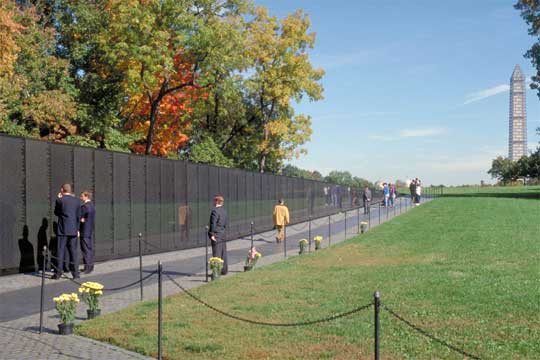
7. Vietnam Veterans Memorial
A black granite wall bears the name of every American military person who was killed in the Vietnam war, over 58,300 names in order by the date of death, from 1959 to 1975. The wall can be overwhelming, given the terrible loss that each of the names represents. The design of the monument is important as well: Its stark Modernism was controversial and ultimately powerful, and every monument since then has been influenced by it and compared against it.
If you know the name of a person on the wall, you can find it listed in books in alphabetical order at each end of the memorial. With the name is the panel number and line number where the name can be found. Park rangers and volunteers are often present to assist. The monument is located in West Potomac Park, just south of Constitution Avenue, and not far from the Lincoln Memorial.
Address: 5 Henry Bacon Drive, N.W., Washington, DC
Metro: Foggy Bottom or Smithsonian
Website: vvmf.org (Vietnam Veterans Memorial Fund, the private organization that built the memorial)
Photograph: © Peter R. Penczer 1999
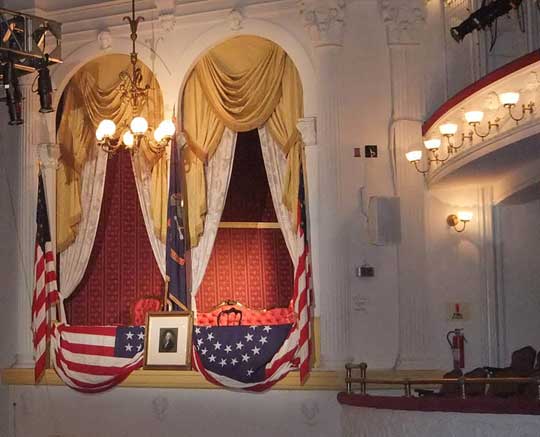
8. Ford's Theatre
Ford's Theatre is the site where Abraham Lincoln was shot on the night of April 14, 1865. It was the final act of the Civil War and a tragedy for the Lincoln family and for the nation. The president was attending a performance of the comedy Our American Cousin with his wife when the actor John Wilkes Booth walked up behind him and shot him in the head. Theatergoers carried him across the street to a boarding house, the Petersen House, where he died early the next morning. After Lincoln's death, the theater was gutted, but it was restored in 1968. Consequently, the only original part of the building is the facade on Tenth Street. Petersen House, however, is completely original in its structure--the furnishings are antique but not original to the house.
Both buildings are now historic sites operated by the National Park Service. Visitors can see the inside of the theater with free timed same-day tickets, or with advance tickets for a fee. There is a museum in the basement of the theater about the assassination. The museum is a must-see, since it has an impressive collection of original objects related to the crime, such as the door to Lincoln's theater box and the dagger that Booth brandished before the crowd. Tickets to see the theater may not be available if it is in use for a live performance, and they do not necessarily include admission to the museum, so be sure to check. Every ticket includes admission to the Petersen House across the street and the adjacent education center.
Address: 511 Tenth Street, N.W., Washington, DC 20004
Metro: Metro Center
Website: fords.org
Photograph: © Peter R. Penczer 2015
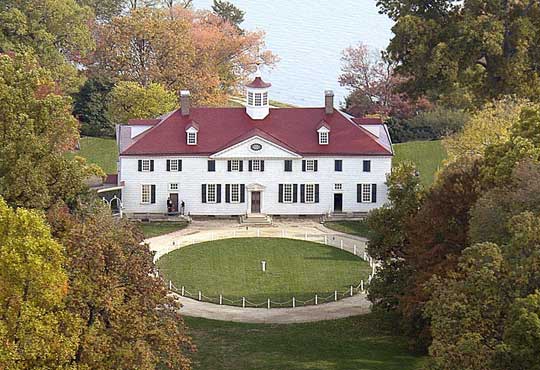
9. Mount Vernon
The home of George Washington, 15 miles south of Washington, D.C., on the Potomac River, is the most historically significant house in the United States. Visitors get a comprehensive tour of the mansion, which is remarkably well preserved. About half of the objects inside actually belonged to Washington, while the rest are historically accurate antiques. Visitors have access to the beautifully maintained grounds, which are perched on a scenic spot above the Potomac River. Not far from the mansion is the tomb of George and his wife, Martha, where their sarcophagi are visible behind a gate, as well as more than a dozen outbuildings, about half of which date from Washington's time.
Mount Vernon is owned and operated by the Mount Vernon Ladies Association, a private society that bought the house from the Washington family in 1858. Near the entrance to the grounds is a museum, a very good sit-down restaurant, a food court, a large giftshop and bookstore, and an introductory film. The latter is one of the best in the business and well worth seeing. In the museum, be sure not to miss the bust of Washington by Jean-Antoine Houdon. Those who knew him said that it was the most accurate likeness of the first president.
Address: 3200 Mount Vernon Memorial Highway Mount Vernon, VA 22121
Metro: The best way to reach Mount Vernon is by car--there is plenty of free parking. It is also possible to travel there from Washington or Alexandria by boat, much as tourists did in the 19th century. Metrorail and bus is another possibility--details are on the Mount Vernon website.
Website: mountvernon.org
Photograph: George Washington's Mount Vernon
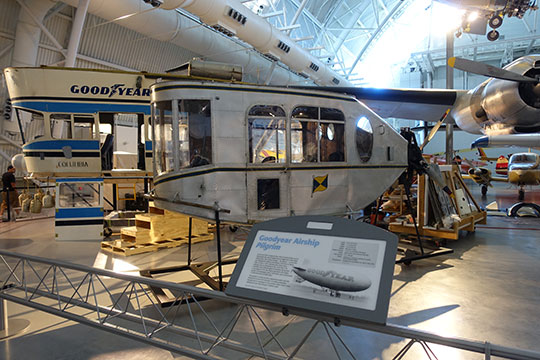
10. Udvar-Hazy Center, National Air and Space Museum
This is one of the most impressive museums that you will ever see. The building--an enormous hanger adjacent to Dulles Airport--houses a huge collection of aircraft, including the Enola Gay (the plane that dropped the atomic bomb on Hiroshima), a collection of rare Nazi experimental planes, a Lockheed SR-71 Blackbird, a Concorde, the space shuttle Discovery, and many other aircraft, spacecraft, and artifacts. There's also an IMAX theater, a tower with a view of Dulles airport, and a large McDonald's restaurant.
The Stephen F. Udvar-Hazy Center is a part of the Smithsonian National Air and Space Museum, and is located 25 miles west of Washington, D.C. It has the aircraft--and spacecraft--that won't fit in the smaller, but still very large, Air and Space museum on the National Mall. Admission is free, but there is a $15 charge for parking in the large lot.
Address: 14390 Air and Space Museum Parkway Chantilly, Virginia 20151
Metro: The Udvar-Hazy Center is only one stop by public bus from Dulles Airport, and there are lockers for luggage. It is also possible to reach the museum from Washington, D.C., by a combination of Metrorail and public bus.
Photograph: © Peter R. Penczer 2016
Copyright © Peter R. Penczer 2018